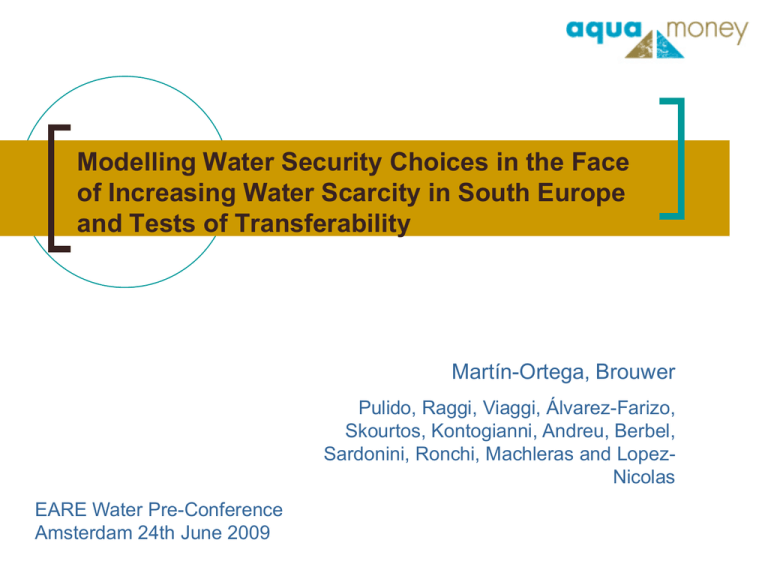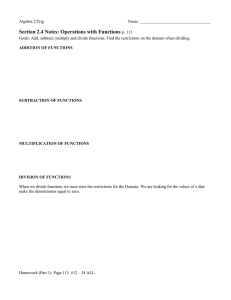Modelling Water Security Choices in the Face and Tests of Transferability
advertisement

Modelling Water Security Choices in the Face of Increasing Water Scarcity in South Europe and Tests of Transferability Martín-Ortega, Brouwer Pulido, Raggi, Viaggi, Álvarez-Farizo, Skourtos, Kontogianni, Andreu, Berbel, Sardonini, Ronchi, Machleras and LopezNicolas EARE Water Pre-Conference Amsterdam 24th June 2009 Outline Background Objectives Study Design & Choice Model First Results Conclusions Background 6th EU FP AquaMoney Project: Guidelines for the estimation of WFD’s environmental & resource costs and benefits Approach: value of the improvement from current and good ecological status of water bodies Focus: the opportunities foregone of not reaching the WFD objectives under scarcity conditions (resource quantity) Background Objetives To assess the costs (or benefits foregone) of water use under scarcity conditions Specifically, to estimate the economic value of: Environmental use of water, i.e. allocating water to the environment to ensure good environmental status under conditions of limited water availability Water availability for households, i.e. reduction of the probability of water restrictions (water security) To test the transferability of the estimated values across 4 Mediterranean RB: common valuation design Case Studies Approach Stated preferences technique (choice experiment) for non-market values Repondents were offered the possibility to pay to ensure: Water flow in the RB Household supply Survey design: attributes ATTRIBUTES Probability of water restrictions in households: Measured through “number of years with water restrictions in the next 10 years” Water for drinking and hygiene guaranteed Baseline: restrictions in 4 years in the next 10 RB environmental quality due to water flow level Defined as the deviation from natural conditions in relation to a set of environmental features (based on WFD levels- Annex V) Baseline: bad status (great deviation from natural conditions) Monetary attribute (6 levels): annual increase on water bill during the next 10 years Survey Design: attributes Example of choice card Which option do you prefer? Questionnaire Structure Part 1: Individual’s relationship / perception and concern in relation to water and the environment Part 2: Valuation: Status quo monitoring questions Credibility / familiarity Choice Experiment: 3 alternatives (A, B and status quo) , 4 choice occasions, 6 versions Follow-up protests identification Part 3: Socio-demographics Survey administration & sampling strategy RB Sample size Survey mode Survey period (2008) Italy – Po 241 Face to face Sept Greece – Lesbos 312 Face to face July Spain – Serpis 394 Face to face July Spain - Guadal 354 Face to face August – Sept Ramdom sample by quotas of sex and age in urban/rural municipalities Cross-sections of RBs population Choice Model Multinominal Logit Model Hausman test for IIA violation, significant in all cases Random Parameter Logit Model Results (I): Perceptions All countries Greece Italy Spain -S Spain-G 92.15 93.4 94.3 61.7 84.1 74.36 91.0 Environment is (very) important (%) 94.3 97.4 Water availability is a (big) problem in region (%) 57.5 50.2 21.7 Environment is affected by water scarcity (%) 80.8 92.0 61.57 Has suffered restrictions in 1 or more years in last 10 (%) 39 47.8 29 18.5 62.5 Thinks his/her household will suffer water restrictions in the future (%) 51.4 58.4 47.93 37.8 63.3 Marginal WTP: Only attribute models € /household per year € per year per hh Greece Italy Spain-S Spain-G 248.0 165.5 303.2 36.4 92.0 19.6 64.0 45.7 183.2 72.9 103.4 48.4 Results (III): Multivariate Analysis Spain –S Spain -Gua Greece Italy ASC - + - + Prob Domestic Supply Restrictions - - - - Env Quality Good + + + + Env Quality Very Good + Ns* + Ns* Cost - - - - Experienced past restrictions * Domestic Supply Restrictions - - - Ns Environment priority in allocation * Env Very Good + + + Ns Expectations future water scarcity + + + + Income + + + + *Income * Env very Good Rsquare + 0.33 0.13 + 0.18 0.18 Results (IV): Policy Scenarios Scenario A 1 year out of 10 Status Quo (poor) B SQ (4 years out of 10) Environ. Quality Good C SQ (4 years out of 10) Environ. Quality Very good D 1 year out of 10 Environ. Quality Very good Results (IV): Policy Scenarios € /household per year GREECE Consumer Surplus ITALY Consumer Surplus SPAIN-S Consumer Surplus SPAIN-GU Consumer Surplus A 244.4 56.5 141.6 47.9 B 288.5 34.2 101.7 49.9 C 348.5 41.8 122.3 52.7 D 406.6 80.5 216.8 58.8 Transferability test: Swait-Louviere (1993) procedure Step 1: H0: βi = βj (controlling for differences in scale parameter) - If H0 is rejected: models not the same (stop test) - If H0 cannot be rejected: go to step 2 Step 2: H0: λi = λj - If H0 is rejected → transfer problematic - If H0 cannot be rejected → transferable models Transferability test: Swait-Louviere (1993) procedure Case study LL(i) LL(j) LL(ij) LR-test (3df) βi = βj? Greece-Italy -989.1 -973.5 -1984.1 43.1 NO Greece-Serp -989.1 -1520.4 -2529.4 39.9 NO Greece-Gua -989.1 -1277.8 -2521.3 508.9 NO Italy-Serpis -973.5 -1520.4 -2503.8 20.0 NO Italy-Guad -973.5 -1277.8 -2301.6 100.6 NO Serpis-Guad -1520.4 -1277.8 -2946.2 296.0 NO Transfer errors 66% 65% 42% 70% Conclusions Clear social interest on water scarcity problems in the studied regions Social interest translates into positive WTP for reducing water scarcity damage Reducing the probability of water restrictions in households and allocating water to the environment for maintaing the ecological status generates significant social benefits To be included in WFD implementation process Conclusions Sensitivity to scope: higher environmental flows generate higher benefits Previous experience and expectations imply higher values for reducing probability of water restrictions Significant transfer errors across river basins Thank you very much www.aquamoney.org


